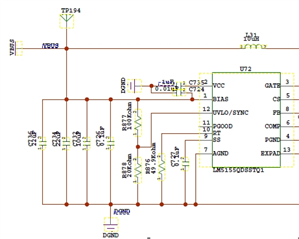Other Parts Discussed in Thread: LM5155
Hi TIer
As shown in the figure below, the LM5155 circuit that we used previously was automatically turned on at power up. We now want to use the microcontroller to master the power supply on and off after power up. is it possible to pull down the 12-pin UVLO/sync by default and control it by serial-resistive IO to 3.3V or 1.8V? Looking at the specifications and design guidelines, it seems like they don't have a case statement like this, does this cause slow start each time you turn on? Also, looking at the timing diagram in the specification book, can the UVLO/sync pull low time be less than 35us, and the power output cannot be turned off?




